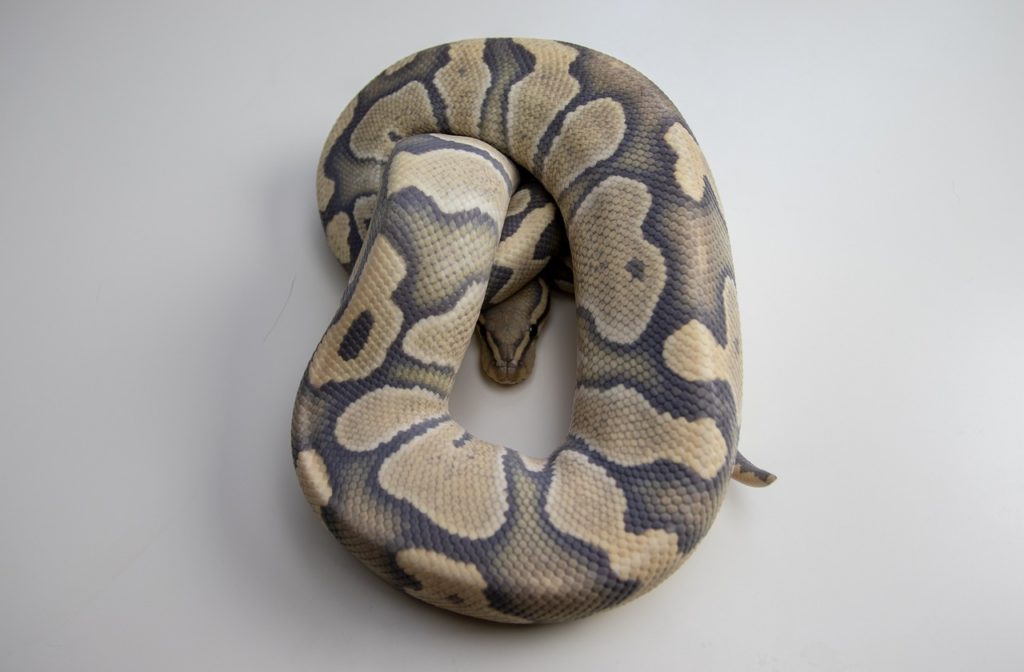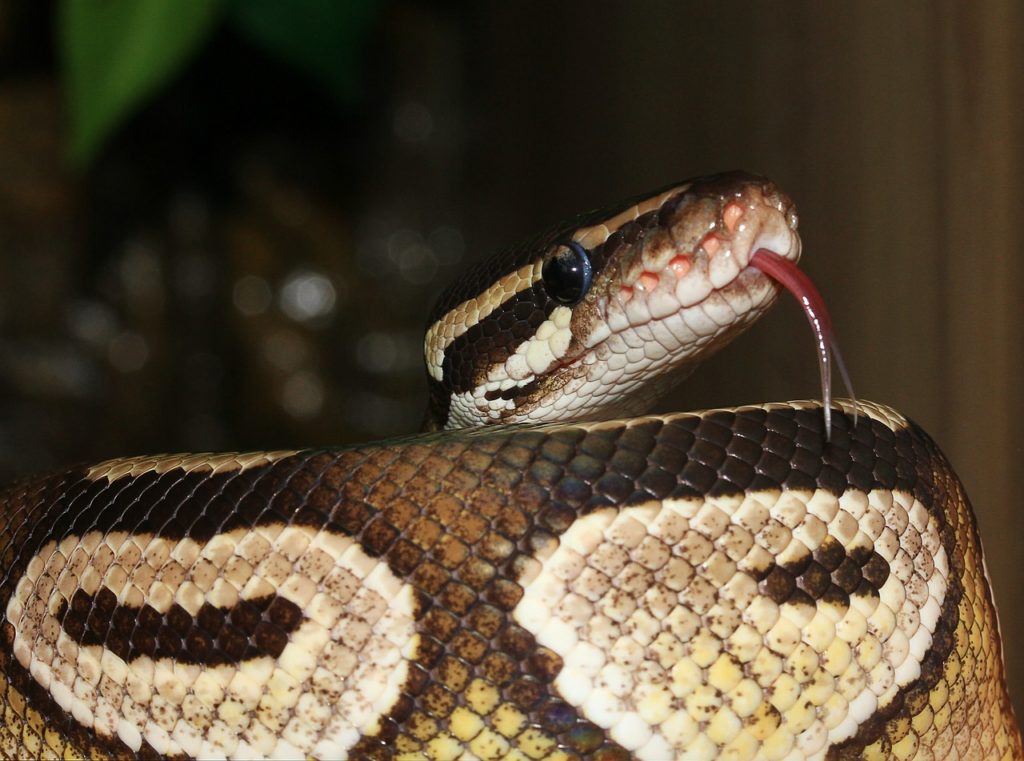The scientific name of a ball python is python regius. A ball is just one round object. Similarly, a ball python tends to curl itself in a tight ball. The pythons tuck their heads inside the coils. Now you can imagine, a snake skinned ball. There it is, a ball python! This is their most distinguishing feature. Ball pythons are native to Africa.

Ball python bite
If a ball python bites you, it does not cause any serious damage. Yet, if a ball python bites you on your face or throat, then you need to seek help immediately. Ball pythons bite when they feel attacked, or think their prey is coming near them. But, ball pythons do not have strong jaws. This is why a ball python’s bite may feel like two accidental needle pricks.
Usually, a ball python might bite and let go, if the prey is still and does not retaliate. In extreme cases, the ball python might latch on to you. And in pulling your hand away, their teeth might break off as well. Ball pythons are not venomous. If the bite is not cleaned up and bandaged soon after, an infection can arise.
A ball python tends to attack and bite under different conditions. One, when they feel vulnerable especially during the shedding of skin. Two, ball pythons bite during feeding. Even after feeding, a ball python can attack you.
Ball python as a pet
A ball python is one of its kind. To house it, can be fairly easy. Ball pythons as pets are very common. Choosing the right ball python is important. Firstly, if you want a rare ball python, it is an expensive affair. The foremost step is asking the breeder about the origin of the python you are interested in.
Ball pythons are rather docile and can live in a glass tank. Ball pythons can be low maintenance! They eat once a week only. If taken care of well, they can live for half a century. Ball pythons love to hide. The glass cage should have different tree barks that are hollow and large enough for it to fit through. A water bowl inside the cage is a must.
Feeding the ball python can be tricky. Touching a ball python when it is sleeping is dangerous. It might mistake you as a predator. Ball pythons are carnivores. They enjoy living in warm enclosures. If the temperature inside the tank is too cold, the ball python is at risk of developing respiratory infections. Look out for how the ball python is behaving. Depending on the morph you adopt, research on the do’s and don’ts is a must. Acquiring a ball python is fairly easy.
Also read about Baby Wolves- here!
Ball python morphs
Morphism refers to a genetic mutation that changes a snake’s appearance. It makes the ball python distinct and unique. A ball python has at least 25 different morphs. The more intriguing a morph, the higher the price for having it as a pet. Albinism that is a lack of melanin is also a type of morph in ball pythons.
Morphism does not state genetic abnormality as such. Rather, a morphed ball python simply has a different genetic makeup. A morphism is a change in the ball python’s physical appearance. The only judge the book by its cover here. It does not hamper a ball python’s life or endanger it.

Here are some interesting ball python morphs
Blue-eyed lucy
This ball python is also referred to as BEL python. The python has blue eyes with pure white skin. The Blue-eyed lucy pythons are very popular as house pets. The common ancestors of a blue eyes lucy area Mojave and a Phantom. Or either one and a different breed. Spotting a BEL python in the wild is like looking for a UFO.
BEL is the creation of breeders. BEL ball pythons are not sensitive to light. Blue-eyed lucy pythons are different from albino ball pythons. The former has Leucism, which refers to a loss of pigmentation. It does not affect eye color. In the latter, the ball python has red eyes and an absence of melanin.
Spider ball pythons
This is among the first morphs of ball pythons that grew popular. The pattern of a spider ball python’s skin is unique in comparison to other morphs. They are very common house pets in the United States. But, spider ball pythons have a dominant genetic defect. This neurological issue is head wobble syndrome.
Spider ball python’s head moves side to side in the wobble syndrome. It moves uncontrollably. This wobble head syndrome decreases their quality of life. The genetic issue interferes when it tries to attack its prey, and while feeding. The extent of the wobble in varies between negligible to nonstop wobbling. Unfortunately, the wobble has no cure and is hereditary.
GHI ball python
GHI here stands for Gotta have it. Seriously. This new morph of ball pythons has become very popular recently. This morph was discovered in 2007.
GHI has a couple of its own morphs. The combinations know no limit. A GHI ball python has very dark skin with light highlights. It also tends to change color at nice. This ball python’s color changes as it ages, and becomes grey.
Ball python size and lifespan
A ball python grows up to a maximum of 5 feet in length. A young ball python grows at least by one foot every year.
In the wild, the life span of a ball python is around 10 years. As pets, ball pythons can live up to 40 years with good care. The shorter lifespan in the wild is because it is prey for the black cobra and large birds.
In West Africa, pythons are a delicacy. Hence, the shorter lifespan. Some ball pythons do not make it to adulthood in the wild.
Ball python facts
- Ball pythons are most active and alert at night. They are nocturnal.
- Ball pythons have a tense posture and continue hissing when they feel threatened.
- A ball python has no fangs. Snakes that have fangs use it to inject venom. Ball pythons have teeth instead.
- Ball pythons have 25 to 35 teeth on average. The number varies across the size and age of the ball python.
- A ball python is also called a royal python.

- A ball python’s eyes turn blue as an indication of shedding that is to come.
- The neck of a ball python is usually in an S shape when it is ready to attack. A coiled up ball python is a defensive one. Beware!!
- A baby ball python is called a hatchling.
- A ball python makes different noises while breathing. Sometimes it could indicate that the ball python is unwell.
- Did you know, a female ball python is larger than its adult counterpart? A female ball python grows to be 3 to 5 feet long. The male ball python’s height only reaches 3 feet.
- A ball python can live up to 50 years. A pet that grows old with you-literally.
This was all about Ball python as a pet. Do your own research before getting one! We would suggest away from snakes in general!
